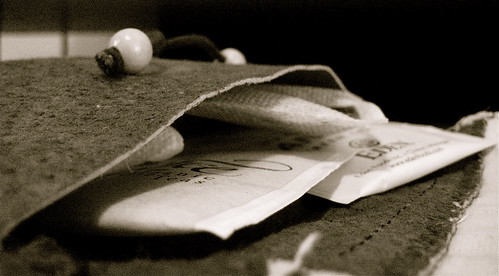Account of a Rib, Being Fractured, Made Whole Again
The Wednesday before last I managed to fracture a rib at Fight Club. It failed to make itself known during class – only later did I inventory a small, sharp pain upon taking deep breathes. My journal that night accounts:
1-2-08 10:12 PM It hurts when I breath. Is that bad?
Thinking nothing of it, I returned to class on Thursday, which proved to be a mistake, the pain after that night being far greater. At this point, I decided that something was not quite right. My next journal entry reads:
1-4-08 8:10 PM My self-diagnosis is that I have a fractured rib. It is either the 2nd or 3rd rib (or both) down from the top on my right side. I don't think it anything serious: my breathing is even, at a normal cycle and depth, and (as near as I can tell) there are no abnormal sounds. This leads me to believe that it is a minor fracture, not a break, and that the lung has not been punctured by a stray splinter. Deep breaths are painful, but not so much as to discourage them. Certain obtuse movements of the right arm, as well as twisting of the torso, causes pain. The most painful act is bending over to tie my boots -- methinks it is gravity dropping all my guts and exerting pressure onto the rib. I now kneel instead. I have yet to cough.
Consulting the medical books I have lying about (and the global interwebs), the only treatment for such an ailment proved to be observing a minimum of one deep breath an hour and a strict rest cure, to last till the rib was healed, which on average takes 2-3 weeks. Clearly, this would not do. A month absent from Fight Club would be regrettable, but a month without running or riding my bike or any other activity that involves frequent deep breaths would not be possible (though the pain was not enough to discourage my normal cycle and depth of breathing, what was previously aerobic had become anaerobic and what was anaerobic was right out). As such, I decided to alter my diet in an attempt to assist the healing process.
Calcium & Silica
Of course, it is common knowledge that bones need Calcium to grow. I dislike milk, but instead increased my intake of almonds, broccoli, carrots and salmon; all of which are rich sources of the mineral. For teas, I purchased Horsetail and Nettle, to supplement the Alfalfa and Chamomile which I already had. Horsetail and Nettle, it just so happens, are also a source of Silica, which, I’ve read, aids in the proper assimilation of Calcium.
Magnesium & Vitamin D
But, surely, Calcium is not all that is required? Further research indicated that both Magnesium and Vitamin D intake should be increased when consuming more Calcium. And what herbs provide an ample source of both Magnesium and Vitamin D? Why, Alfalfa, Horsetail, and Nettle, of course! It’s almost as if Mother Nature knows what she’s doing. Food sources of Vitamin D include egg yolk, salmon, and sweet potatoes. Food sources of Magnesium may be seafood, apples, bananas, brown rice, and salmon.
Phosphorous & Copper
Care should be taken to increase the amount present of two other minerals, as well: Phosphorous and Copper. Eggs and salmon, it turns out, are excellent sources of Phosphorous. Copper may be acquired through almonds. (Side note: I’ve discerned that it is not possible to kill oneself by eating too many sprouted almonds. If it were, I surely would be dead by now.)
Results
So my diet changed to consist of much salmon, brown rice, carrots, apples, bananas, broccoli, with the odd sweet potato and a hard boiled egg once a day. Whenever I felt the need to munch on something, I’d toss down a handful of sprouted almonds (as I’m doing right now). Each morning I would have a cup of Nettle tea, each night a cup of Horsetail tea. If I felt the desire for tea in the middle of the day, I would mix together a bit of Chamomile with a bit of Alfalfa.
All said and done, the rib healed in a week and a half.
Did my diet influence that? Well, diet couldn’t not influenced the body, but as this is the first time I’ve fractured a rib, I’ve no bench-line against which I can measure; save only that the Medical Establishment deemed 2-3 weeks an appropriate number to publish here and there. It certainly didn’t hurt.
(Food and herbal sources of vitamins and minerals were all gathered from the CedarLily Vitamin & Mineral chart that John Gallagher used to sell.)
